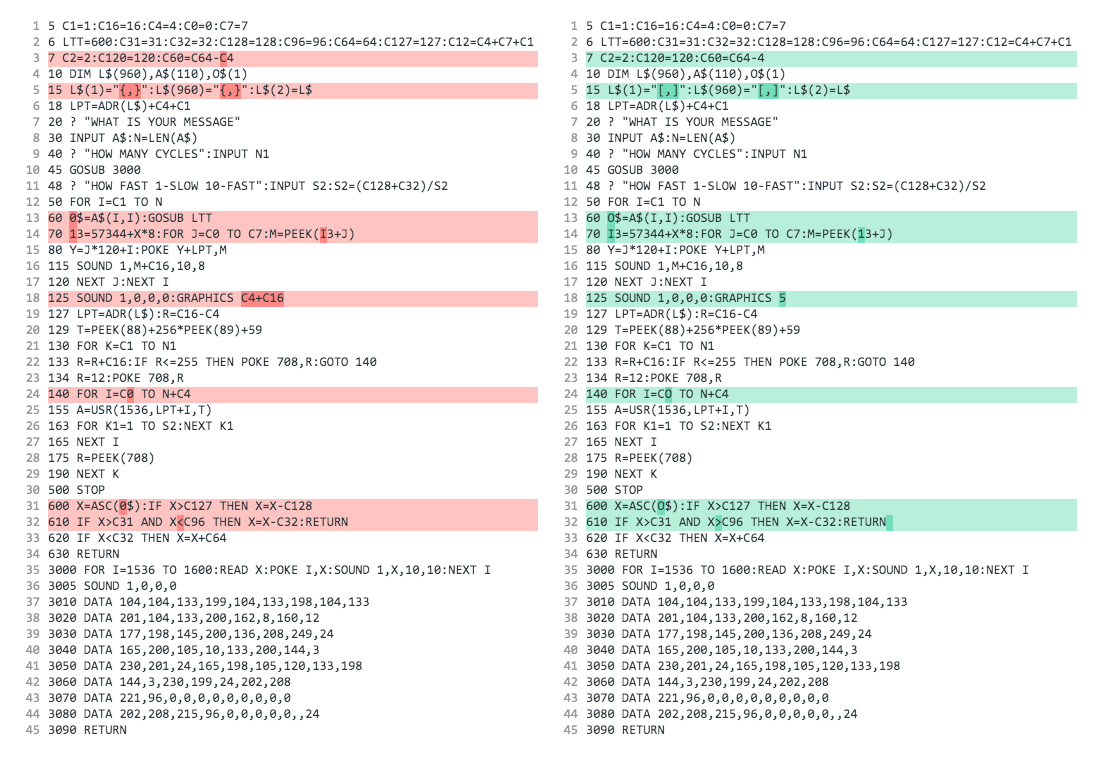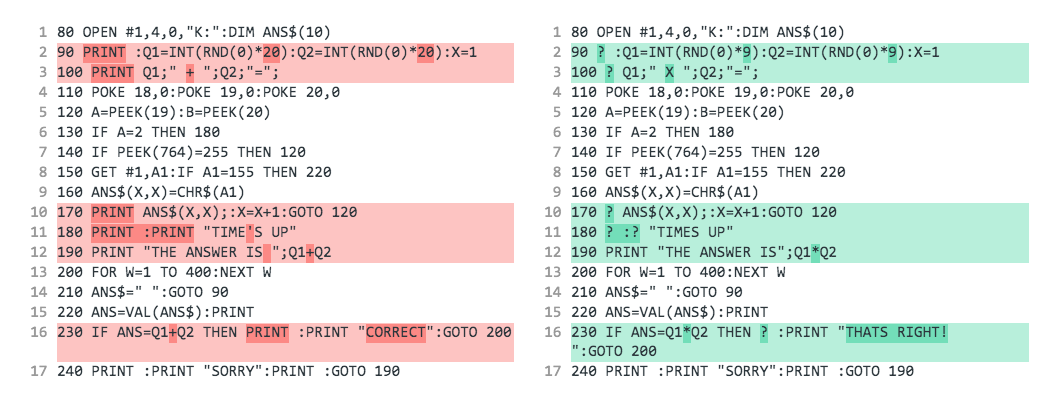
Side 1 of an old cassette tape I used to store programs for my Atari 8-bit computers.
Last weekend, I was rummaging through my old Atari ST disks when I came across something I hadn’t noticed in 30 years: A cassette tape for my Atari 8-bit.
As I have recounted before, I used hand-me-down Atari 800s, a 130XE, a 410 program recorder, and lots of other equipment and disks from family members when I was a kid before later graduating to the 16-bit ST series. Alas, I got rid of most of it when I was in college.
But here was this little tape … perhaps my only tangible link to my old Atari 8-bit equipment.
Each side of the tape was only 10 minutes long. What was on it?
I hoped it might be my own original programming. I used the Atari 8-bits most heavily while I was in elementary school and junior high. At that time I was doing some rudimentary BASIC programming at school on Apple II computers.
I thought stories might be another possibility. As a kid, I wrote lots of stories and essays for school in AtariWriter. I would print these on an Atari 825 dot-matrix printer, which I had proudly purchased from A-Z Used Computers with my own money.
Do you enjoy my retrocomputing research on Break Into Chat? Please join my email list so I can share future projects with you. 📬
Digitizing the tapes
I grabbed a boombox cassette player and connected its headphone jack to the auxiliary input on my Mac Pro. I carefully played back each side of the tape and recorded the audio in Amadeus Pro. I saved the audio files in .WAV format since it is a lossless format and wouldn’t distort the data.

Screenshot of the waveform from the cassette as seen in Amadeus Pro
After some digging online, I downloaded and installed liba8cas and its related tools, then used it to convert the .WAV files into .CAS files which can be understood by Atari 8-bit emulators like Atari800MacX.
I did run into one issue — initially when I saved the .WAV files, I used 32-bit sampling depth. liba8cas didn’t like the huge files. So I re-saved them at 8-bit depth, and the resulting smaller files converted just fine.
Finally, it was time to fire up Atari800MacX. By this time I had done more research, and I felt sure that the tape must hold BASIC programs. One by one I tried CLOAD-ing them from the .CAS tape files. Most of them seemed to load fine. I tried to run each program, and then I would dump the source listing to a text file.

A screenshot of the “Joystick music” program as displayed in Atari800MacX
Ultimately I found the cassette contained at least ten Atari 8-bit programs, typed in from listings in old books and magazines.
We had a pretty big collection of Atari books, but I have no specific memories of typing these in. But I’m sure it was me. Neither of my brothers would have done it. I remember my dad once typing in a very long game from an Atari book, but I think that was probably the only time he did that. No, this was surely my work.
Finding the programs
Finally, I wanted to learn the origins of these programs. Which books did they come from?

A page from “The best of ANTIC: an anthology” containing the Drop program.
By searching Google for snippets of code from each program, I was able to identify 7 of the 10 programs as type-in listings in various Compute! and ANTIC magazines and books. Here’s a list of the seven:
| Program | Source | Pages | Article links |
|---|---|---|---|
| Drop | The best of Antic: an anthology | 141-144 | archive.org atarimagazines.com |
| Fast Banner | Compute’s Second Book of Atari | 209-212 | archive.org atariarchives.org |
| Color Wheel | Compute Magazine, 1980, Issue 5 | 64 | archive.org |
| Shading demo | Compute Magazine, 1980, Issue 4 | 97-98 | archive.org |
| Timed math quiz | Compute’s Third Book of Atari | 25 | archive.org atariarchives.org |
| Box hunt | Compute’s Atari Collection | 99-100 | archive.org |
| Graphics 8 colors | Compute’s First Book of Atari Graphics | 203-204 | archive.org atariarchives.org |
I don’t think the other three are original programs. They probably came from other sources that aren’t searchable, like the ACE-St. Louis newsletter.
Checking my work
When I tried to run the programs in Atari800MacX, I noticed that several didn’t quite work right.
Since I was able to find the original listings, I thought it would be fun to check my work.
I used a diff tool to compare my versions of the programs with the source listings I found on atariarchives.org or atarimagazine.com.
Unsurprisingly, my listings had mistakes — but so do the sources listings on the magazine websites! Most of those are the result of OCR, however.
For example here’s a comparison of my version of “Fast Banner” with the listing as presented on atariarchive.org.

A diff comparison of my version of Fast Banner (on the right) with one from a website (on the left).
It’s clear I made quite a few typos. On line 7, I omitted the “C” from the variable “C4”. On line 125, I changed “Graphics C4+C16” to “Graphics 5”. And on line 610, I had a greater-than sign where I should have had a less-than sign.
But the website listing has a number of OCR mistakes as well. “O”s and “0”s are mixed up everywhere.
The diff tool also revealed a few places where I customized the programs. For example, in “Timed Math Quiz”, I changed the program to display multiplication problems instead of addition problems:

A diff comparison of my version of Timed Math Quiz (on the right) with one from a website (on the left).
I humanized the program, too, changing the robotic “Correct” to a friendlier “That’s right!”
The diff also shows I had picked up a few BASIC tricks by this time. These programs could be exhausting to type in, and anything you could do to shorten the time spent typing was good. In this case, I made extensive use of “?” as a short form of “PRINT”.
More unearthing
It was so much fun to find this cassette and try to extract its secrets. Why stop there?
In coming weeks, I’ll be sharing the results of other digital recovery I’ve done recently. These are not my own games or programs, but other folks’ work that I have helped salvage from disks or archives:
- An Atari ST game called “Dark Fortress”
- Source code for the BBS door game “Thieves’ Guild”
- The Atari ST biotoons “Mom and Me” and “Murray and Me”

That’s awesome! I learned to program in grammar school by typing in the code from Antic as well on my Atari 800.. I wish I had some of my code from back then. I ran and co-ran a few popular BBS’s and either heavily modified different versions of FoReM and Carnival, as well as wrote my own BBS using the MOE from, I think, Carina?.. Wrote a few games for the BBS’s as well (ideas copied from others but written from scratch) like 38 column dash, archery.. one where you had to “hack” into a computer system like Wargames.. good stuff. Most popular program I wrote was a code finder for phreaking lol.
Hah, very cool. I couldn’t tell though – were you disappointed in what you found? It sounded like you expected to find some of your own programs, not just programs you typed in.
That’s a great question. I probably was a little disappointed.
But though I didn’t find exactly what I set out hoping to find, what I *did* uncover was still pretty interesting. I enjoyed comparing my saved versions of the programs with the originals.